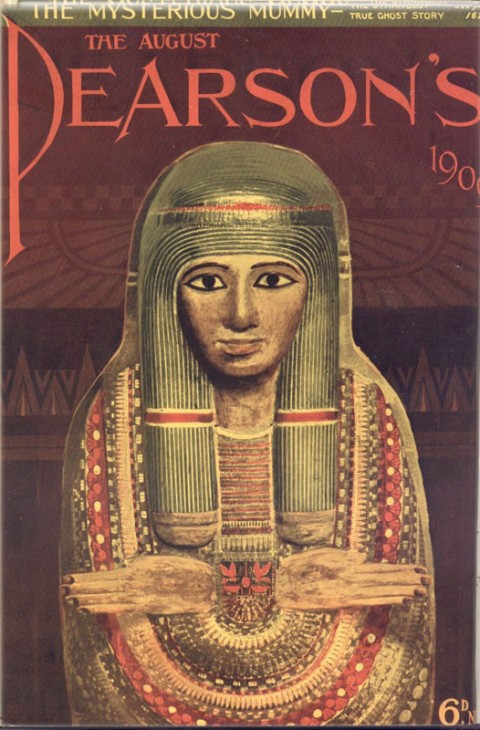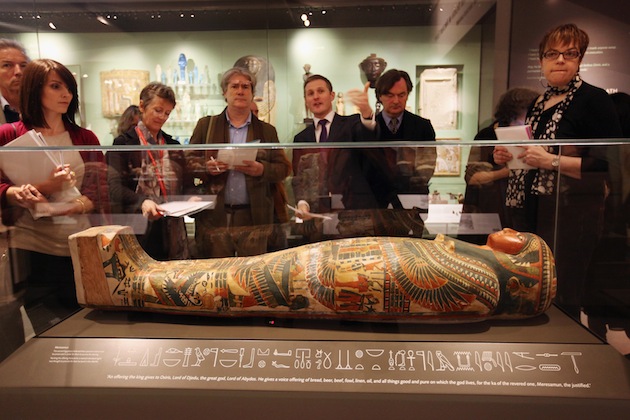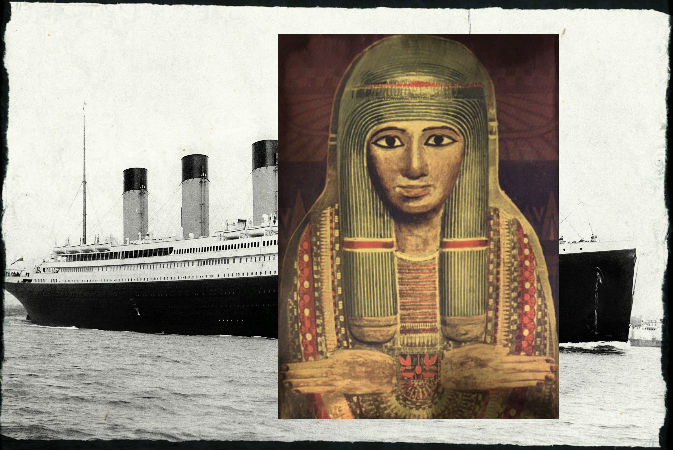
|
|||
Curse of the Egyptian Princess aka Unlucky Mummy That Sank TITANIC - Unexplained Mysteries
See more at: http://www.titanicandco.com/curse.html
Was the disaster of TITANIC caused by an Egyptian Mummy lying in the Cargo hold of the Titanic? The mummy-board has acquired a reputation for bringing misfortune, and a vast web of mythology has developed around it. It has been credited with causing death, injury and large-scale disasters such as the sinking of the RMS Titanic in 1912, thereby earning the nickname 'The Unlucky Mummy' On the 12th April 1912 the Titanic was crossing the Atlantic on her way to New York on her maiden voyage. All seemed to be going well on the voyage. A group of eight people gathered in the first class smoking room to discuss the meaning of life. One of the group was William T Stead, the English journalist and Spiritualist. As the evening progressed Stead began to tell a ghost story which would open the flood gates to legends and myths surrounding the Titanic and her sinking for decades to follow. He boasted that he was not superstitious as he pointed out that his story began before midnight on the 12th April and ended shortly after midnight. The story concerned the finding of an Egyptian Mummy and the translation of the inscription on the Mummy's case. The inscription warned that whoever should verbally recite the inscription would meet a very violent death. The seven other members listened with sinister curiosity. Could Stead have been serious? Was there such a curse? Where was the Mummy - surely not onboard the ship they were travelling on? Seven men out of the eight went down with the ship, including Stead himself although he had already had a premonition about his death some time before. The only survivor from the group was Fred Seward , who later when asked about the Mummy story told them that he would never dare retell it. Over the years there have been many different accounts of the Mummy's curse but after careful research the answer seems quite clear.
The third man in the foursome found on his return home that the bank holding his entire savings had failed. The fourth suffered a severe illness, lost his job and was reduced to selling matches in the street. Nevertheless, the coffin eventually reached England (causing other misfortunes along the way), where a London businessman bought it. After three of his family members had been injured in a road accident and his house damaged by fire, the businessman donated it to the British Museum. As the coffin was being unloaded from a truck in the museum courtyard, the truck suddenly went into reverse and trapped a passer-by. Then as 2 workmen were lifting the casket up the stairs, 1 fell and broke his leg. The other, apparently in perfect health, died unaccountably two days later.  Once the Princess was installed in the Egyptian Room, trouble really started. The Museum's night watchmen frequently heard frantic hammering and sobbing from the coffin. Other exhibits in the room were also often hurled about at night. One watchman died on duty. Other watchmen wanting to quit. Cleaners refused to go near the Princess too. When a visitor derisively flicked a dust cloth at the face painted on the coffin, his child died of measles soon afterwards. Finally, the authorities had the Mummy carried down to the basement figuring it could not do any harm down there. Within a week, one of the helpers was seriously ill, and the supervisor of the move was found dead on his desk. By now, the papers had heard of it. A journalist photographer took a picture of the Mummy case and when he developed it, the painting on the coffin was of a horrifying, human face. The photographer was said to have gone home then, locked his bedroom door and shot himself. Soon afterwards, the museum sold the Mummy to a private collector. After continual misfortune (and deaths), the owner banished it to the attic. A well-known authority on the occult, Madame Helena Blavatsky, visited the premises. Upon entry, she was sized with a shivering fit and searched the house for the source of an evil influence of incredible intensity; She finally came to the attic and found the Mummy case. Can you exorcise this evil spirit? Asked the owner. There is no such thing as exorcism. Evil remains evil forever. Nothing can be done about it. I implore you to get rid of this evil as soon as possible. But no British museum would take the Mummy; the fact that almost 20 people had met with misfortune, disaster or death from handling the casket, in barely 10 years, was now well known. Eventually, a hard headed American archaeologist (who dismissed the happenings as quirks of circumstance), paid a handsome price for the Mummy and arranged for its removal to New York. In Apr 1912, the new owner escorted its treasure aboard a sparkling, new White Star liner about to make its maiden voyage to New York. On the night of April 14, amid scenes of unprecedented horror, the Princess of Amen-Ra accompanied 1,500 passengers to their deaths at the bottom of the Atlantic. The name of the ship was of course, the RMS TITANIC. Some accounts of the story go on to say that the American collector bribed the crew of the Titanic to put the Mummy in a lifeboat and was smuggled onboard the Carpathia when she picked up the Titanic survivors and landed safely in New York. In America the Mummy continued to bring tragedy to those that handled the coffin and so it was shipped back to Europe on the Empress of Ireland which then sank with the loss of 840 passengers on the 29th May 1912. Somehow, the Mummy was saved again. The collector decided to ship the coffin back to Egypt on a third ship, the Lusitania. The ship was torpedoed by a German submarine. What happened after that is not known. FACT OR FICTION Was the Mummy of the Princess of Amen-Ra onboard the Titanic and did she sink her? In short NO to both questions. The whole story is nothing but an elaborate ghost story created by two over-imaginative minds of William Stead and Douglas Murray . They actually made up two distinct stories. The first concerned an acquaintance of theirs who acquired an Egyptian Mummy and displayed it in his drawing room. But the morning after setting it up all breakable items in the room were smashed up. Each time the Mummy was moved all pieces of breakables were broken. The second story followed a visit to the British Museum. They saw the coffin lid of the Priestess of Amen-Ra and imagined a coffin whose picture on the front was one of sheer terror and anguish in the face depicted on it. The coffin's original occupant was a tormented soul and her evil spirit was loose in the world to bring misery to those who got in her way. Stead and Murray sold their story to the press who were not bothered about publishing the truth.  THE UNLUCKY MUMMY It must be examined as to what prompted Stead and Murray to concoct the stories. Was there any truth in what they said? Following many investigations the Mummy in question has been nicknamed the "Unlucky Mummy" because it has acquired a reputation for bringing misfortune, injury, death and large scale disasters (including the Titanic). Many writers on the internet like to give the impression that the British Museum cannot or will not explain the curiosity behind the "Unlucky Mummy". This is simply not true . Since the British Museum exhibits the coffin lid of Priestess of Amen-Ra in Room 62 . The "Unlucky Mummy" is not a Mummy at all. It is a painted wooden "Mummy-board" or inner coffin lid (about 162 cm tall). The British Museum display the case under EA 22542 . The lid was found at Thebes. Its shape and the style of decoration dates to the late 21st or early 22nd Dynasty (c.950-900 BC). It is thought that the coffin would have contained a woman because the picture on the lid depicts a beardless face and the position of the hands with fingers extended illustrates a lady not a man. The identity of the person is not known because the hieroglyphic inscriptions contain only short religious phrases and do not give any indication who she was. However, the rich quality of the lid suggests that she would have held quite a high rank (A Wallis Budge, Keeper of Egyptian and Assyrian Antiquities from 1894 to 1924 thought she was of Royal blood but this has never been known or proved). Her stature in life was not dissimilar to those ladies who participated in the musical accompaniments to the rituals in the temple of Amen-Ra. Because of this connection the "Unlucky Mummy" earned the name "Priestess of Amen-Ra" and indeed was described as such in early British Museum publications. The coffin lid was presented to the British Museum in July 1889 by Mrs. Warwick Hunt, on behalf of her brother Arthur F. Wheeler. It was displayed in the "First Egyptian Room" of the Museum as early as 1890. It must be pointed out that the lid has not been moved since (except for war times when it safety was at risk and for special exhibitions abroad). SO WHAT HAS THIS TO DO WITH THE TITANIC MUMMY? Absolutely nothing. It is clear that the story of the Priestess of Amen-Ra has been mixed and confused with the concocted supernatural tale of Stead and Murray. The story was given more credit when the survivor from the Titanic told how Stead had told his story on the 12th April. However, in 1985 Charles Haas, President of the Titanic Historical Society gained access to the original Titanic's cargo manifest only to find no mention of a Mummy. In Haas' words "the cargo manifest throws those myths right out of the window." There was no Mummy on board the Titanic. The only Mummy in question was the Priestess of Amen-Ra. Her coffin lid did not leave its display in the British Museum and so was never onboard the Titanic. However, the British Museum was never presented with the actual Mummy. Mr Taylor and the Egyptian Artefacts team think it is most probable that the Priestess' remains were left behind in Egypt. It is perhaps this fact that William Stead used to concoct his macabre tale. Without the Priestess herself perhaps we will never know what happened to her!? comments powered by Disqus Submit News/Videos/Links | Discuss article | Article Link More Unsolved and Unexplained Mysteries |
More can be addded on request. Direct your requests at vinit@theunexplainedmysteries.com
